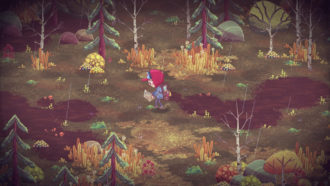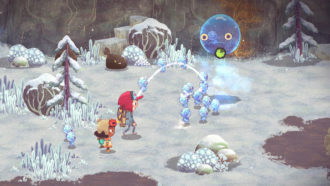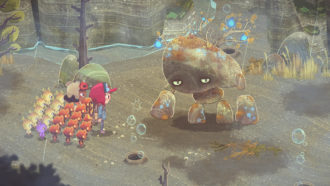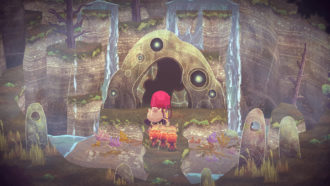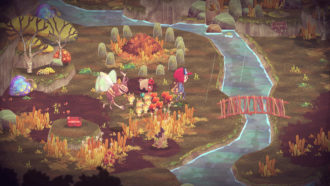Platforms:
Xbox One, PC, Xbox Series X|S
Released:
May 20, 2021
Publisher:
Humble Games
Developer:
Moonlight Kids
The Wild at Heart is a story-rich action-adventure game about childhood escapism. Take command of a magical swarm of curious creatures to battle precarious wildlife and supernatural foes, construct and craft new pathways, and discover the secrets of a forgotten world.
At first glance, this charming and wonderous game seems light-hearted, however, within minutes my heartstrings ached as we learn our protagonist, Wake, comes from a broken home. He’s decided to run away with his friend Kirby to a destination unknown. He leaves a note for his father, making comment that his dad might not even care. The heartstrings pull again. Wake gets lost on his journey, becoming tired, cold and afraid in the rainy forest. A strange creature approaches him. Unsure of what else to do, Wake follows the creature unknowingly into the Deep Woods. It’s here when things turn magical and confusing. We meet Greybeard whose perplexing speech offers little explanation. All we know is that ‘the dark is bad’. With little else to go by, we decide to trust this stranger and follow him further into the woods, hoping that whatever danger lies ahead is less scary than the danger left behind. And this is where our adventure truly begins.

Playing The Wild at Heart feels familiar but also new. Between the influences of Pikmin, Overlord and Luigi’s Mansion, the game shouldn’t work, but it does. Seamlessly. The main mechanics are incredibly fine-tuned and intuitive. Everything has been carefully thought through to make sure the player has the best experience possible. There is a crafting system that whilst easy to manage seems obsolete until late game, and the game’s overlay and menu system gives you everything you need in a simple and accessible format. However, let’s start with the world. It’s open and vast with mysteries to explore, items to find and puzzles to solve, but paths are blocked until you acquire the necessary tools to move forward. You might need to find a gear to help turn a windmill that will open a gate, which will lead you into a new area with new problems to solve. Like any good puzzle-solving game, the curve in difficulty is fair and when puzzles are difficult, they’re not objectively obtuse.

You control your protagonists Wake and Kirby, each with their own abilities that can be upgraded. Wake uses his modified ‘Gust Buster’ vacuum to suck up items or turn windmills whilst Kirby acquires a magical lantern. Kirby is also smaller than Wake so can get into small spaces. That part comes in handy a lot. It’s not only the two children you control though, you also have your Spritelings. Controlling your Spritelings is very similar to Pikmin and Overlord. You command your little friends to pick up items, break down walls, move giant boulders or attack nasty boys. There are different Spritelings that are used for different tasks as well, effectively blocking paths and areas of the map until you acquire the right Spriteling for the job. They aren’t invincible though, and you do find yourself getting distressed when many of them suddenly drown or get eaten by a monster. Like in Pikmin, you can find seeds to regrow the forest spirits and resummon them. The controls can feel a little clunky at times. Making sure you are pointed in the exact direction to both release and return Spritelings can be a little frustrating. However, in both aforementioned games, this mechanic seems to always have this sort of control issue, which makes me wonder if it’s deliberately part of the challenge.

You find early on that there is an evil lurking in the dark, the Never, which is why the dark is bad. This is where mechanics reminiscent of Don’t Starve or Minecraft come into play. When the night comes you need to be in the light or in bed otherwise the ‘Never’ spawn and it’s game over. It adds a sense of urgency to the gameplay and requires the player to return to camp to rest and end the day. The extra layer of danger and time limitation made some seemingly easy puzzles more complex. Regardless, I found myself utterly intrigued with the storyline and the storytelling along the way. There is something to be said about games that respect the player enough to let them experience things firsthand before handing explanations on a silver platter. I had many an ‘aha!’ moment which felt like accomplishments along the way.

NPCs that seemed unimportant were also given substance and meaning. Everyone had their place in the story and nobody was thrown into the background. It’s simply charming. The story also is fleshed out in hidden notes found around the world that helps fill in blanks in the narrative. This allows the story to be told without forcing the player to sit through lengthy cutscenes or forced NPC chatter. More often than not it was worth reading the extra lore to understand and gain a greater insight into the world. It was this information that gained me a greater appreciation for the story’s conclusion. It’s easy to forget a game when you walk away. Usually it’s either the people you play it with or the game’s overall experience which sticks with you. Just like how Broken Age has always clung to me as a storytelling masterpiece with so many little twists and turns, The Wild at Heart has also stuck with me. I think it will be a story I remember for years to come.
“Moonlight Kids was able to capture the innocence and whimsy needed to create an immersive world to play in.”
It is undeniable that the design of The Wild at Heart is extraordinarily beautiful. I was instantly drawn in by the unique art style. I didn’t care what the game was about, I just knew I needed to experience it. Moonlight Kids was able to capture the innocence and whimsy needed to create an immersive world to play in. Everything from the character design, the world-building, interactable items and monsters are all beautifully unique to the game. Nothing is out of place and everything is designed specifically to live within this world. The sound and music design complements the artwork amazingly. The music both lulls you into a sense of hope and determination whilst also scaring you out of your pants when night dawns and the Never monsters appear. These elements make for a truly engaging and immersive world to play in with little to no break in the illusion that you aren’t actively involved in the game’s storytelling. This alone is worth considerable mention and a kudos to Justin Baldwin, Chris Sumsky, Ankit Trivedi, Alex Atkind, Amos Roddy and Matt Morgan, the team who brought this story to life in a magnificent display of art, code, music and design.
8
Great
Positive:
- Immersive and engaging storytelling
- Gorgeous art style and cohesive design
- Intuitive music and sound design
- Intuitive gameplay mechanics and puzzle design
- Characters are all imperative and compliment the story
Negative:
- Some puzzles may cause younger players frustration
- Crafting and items seem unnecessary
The Wild at Heart is a story-rich action-adventure that draws you in and pulls at your heartstrings as we follow two children, Wake and Kirby, as they discover who they are and where they belong. The immersive and detailed storytelling and intuitive gameplay make The Wild at Heart a beautifully crafted showpiece. Whilst some of the gameplay further into the experience can feel repetitive and some mechanics are either underutilised or unnecessary, this is still a game worth sharing with people of all ages as it offers unique experiences for each player. Moonlight Kids have done an amazing job creating this unique and wonderful world and the story within. If you are an avid lover of puzzle adventure games that involve weird and wonderful creatures, coming of age stories, battles against supernatural foes and uncovering secrets, then The Wild at Heart is something you absolutely must experience for yourself.
